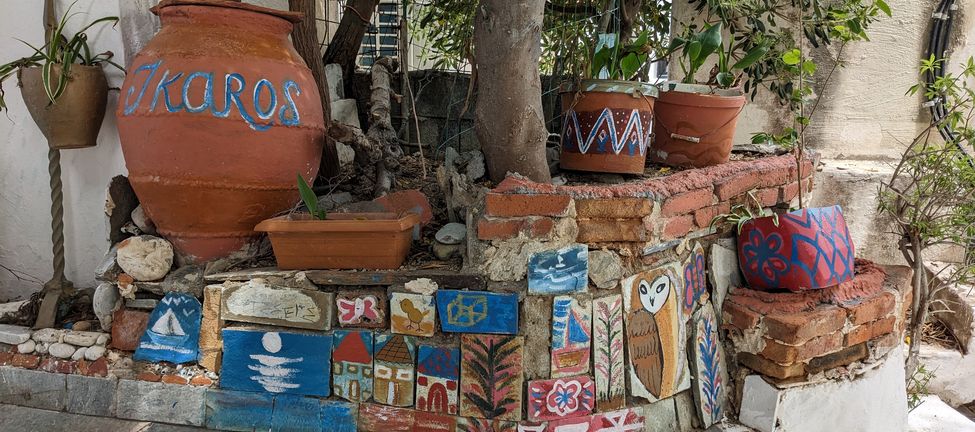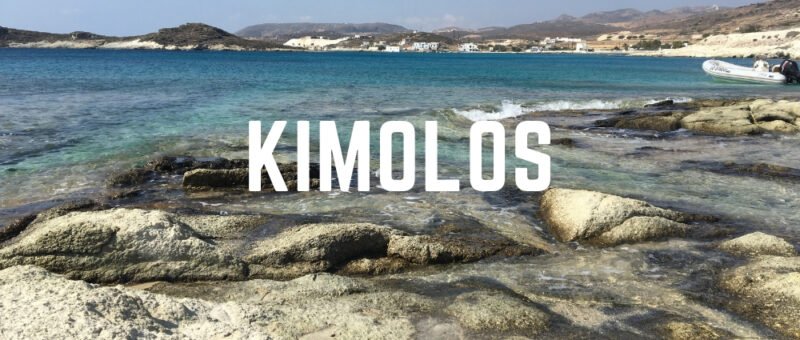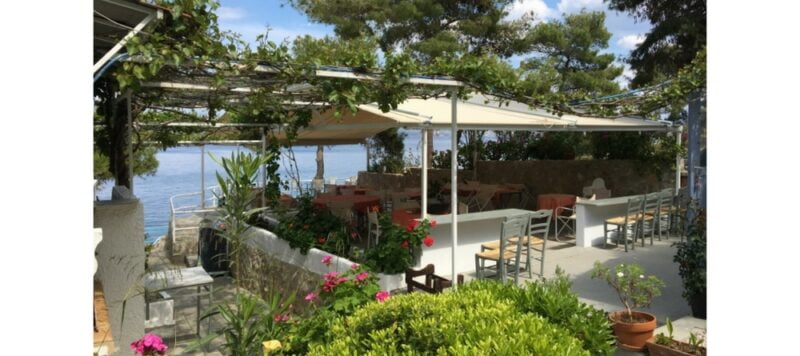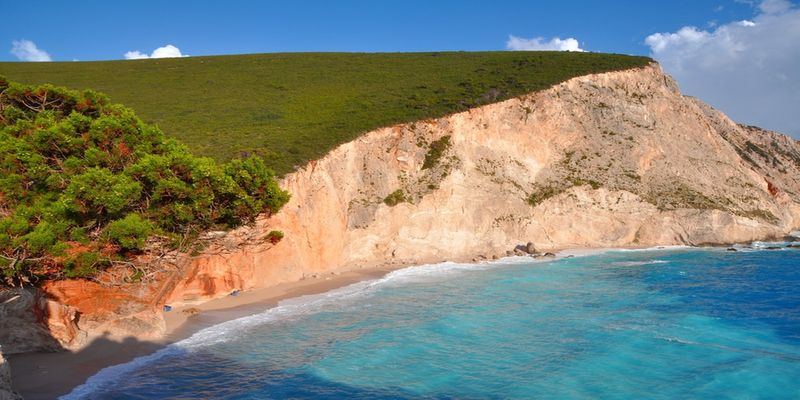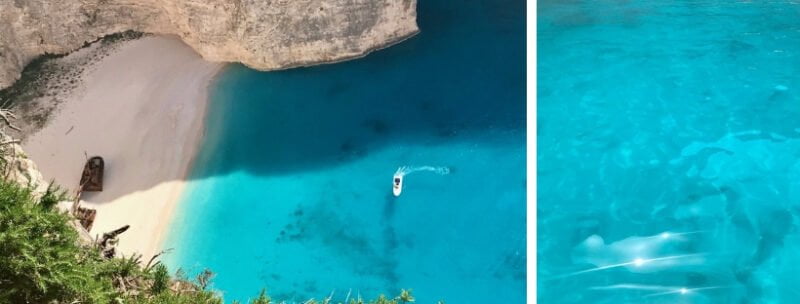Ikaria, or Nikaria (Nicaria) in Greek, is an island in the eastern Aegean Sea between Samos and Mykonos in Greece. Its name comes from Icare, in Greek mythology. He was the one who flew too close to the sun with his wings made of feathers glued to wax… and so fell into the sea. Far from mainland Greece and mass tourism, visit Ikaria this authentic, unspoilt island of Aegean Sea. It offers beaches with translucent waters, picturesque villages, large forests and canyons for hiking, thermal springs…
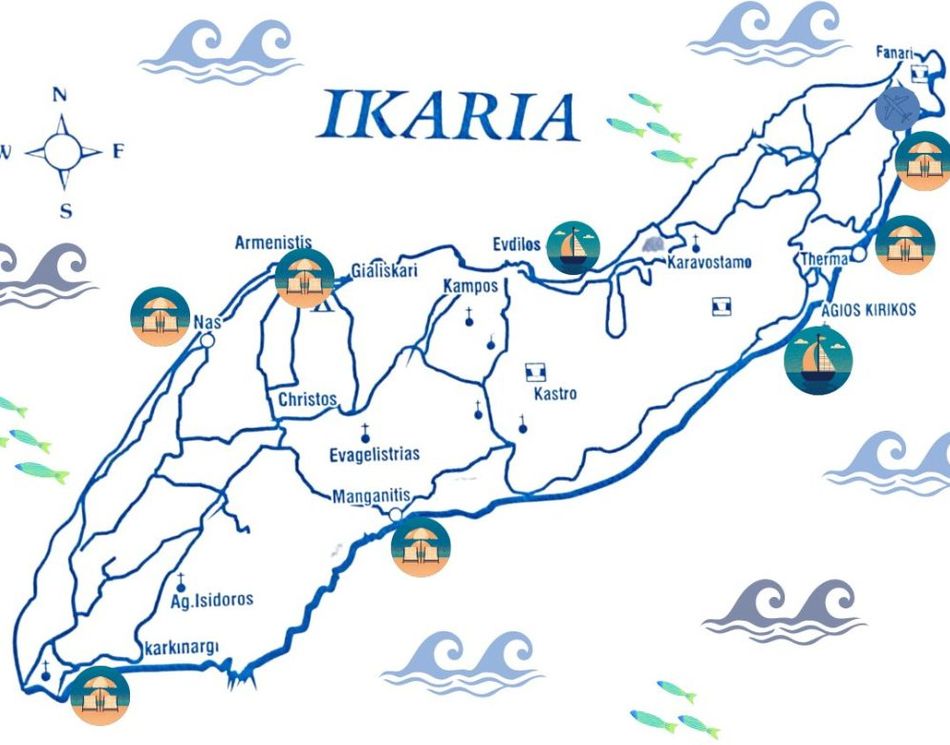
All this, combined with healthy local cuisine, a joyful, stress-free way of life, and great solidarity among the locals… Perhaps this is the secret of this “Blue Zone” island, reputed to be the island of centenarians? So, what to visit, see and do in Ikaria? Let’s get started with our 10 must-sees during your stay in Ikaria!
- 1- Basking in the hot springs at Ikaria
- 2- Explore the island’s two main port cities
- 3 – Stop off in small fishing villages
- 4 – Discover the most beautiful beaches on the island of Ikaria
- 5 – Take a stroll and hike along the paths of Ikaria
- 6 – Discover the amazing monastery of Ikaria
- 7 – Visiting archaeological sites
- 8 – Spend the evening in mountain villages like Rahes
- 9 – Attend one of the many panigyria
- 10 – Tasting Icariote specialities
You can also find our travel tips to prepare your stay in Ikaria: How to go there? Getting around? Where to stay? Where to eat?
1- Basking in the hot springs at Ikaria
During our stay at the end of April, the sun was out but the sea was still too cold to enjoy it. But we were still able to enjoy a dip in the sea, as Ikaria has several thermal springs. Be careful: in some places, the water can be very hot (up to 60-70 degrees). Here’s where to go to enjoy the many therapeutic benefits of these hot springs (rheumatism, skin diseases…):
- Therma spa : The hot spring is located on Therma beach, in a natural open-air grotto just off the port. Access to natural thermal baths is free, 24/24, and is located to the right of the pontoon, via a ladder that plunges directly into the cool sea water. A very quick, alternating hot-cold swim and you’re at the bottom of the cave. Sit on the rocks among the small fish and crabs and enjoy the warm water that gushes out in many places. In the small town of Therma, the Apollon Spa center in the main square offers fully equipped baths and hammams. It is generally open from June to October.
- Just above the village of Therma, the open-air hot springs of Chalasmena are also open to the public.
- South of Agios Kirykos, near the village of Glaredos, you’ll find other hot springs in the heart of nature: Lefkada Spa. Formerly organized in the 50s and 70s and then abandoned, they are now freely accessible, with large stones creating a small pool in the sea.
- Another natural hot spring can be found at Agia Kiriaki near the airport. With free access, it is located near the beach (Google Maps point) and even has a changing room.
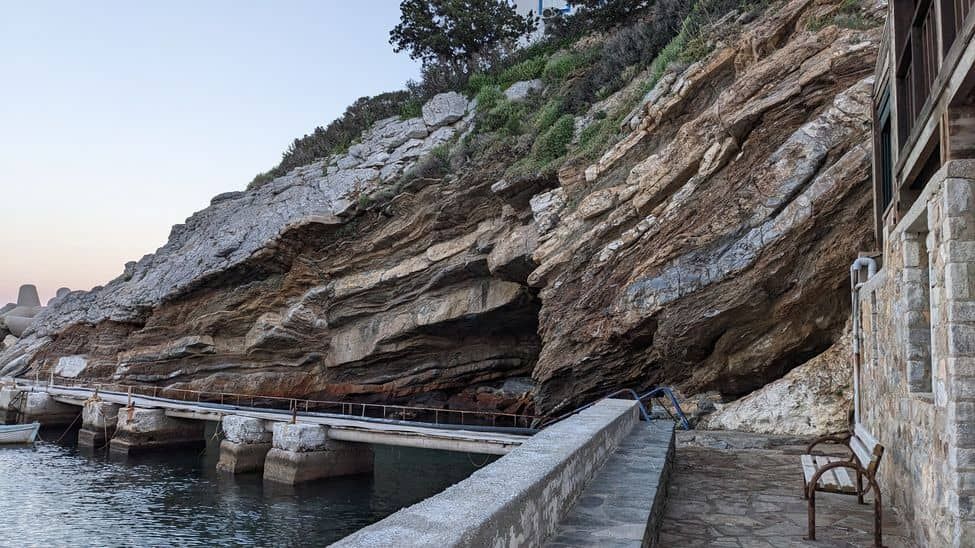
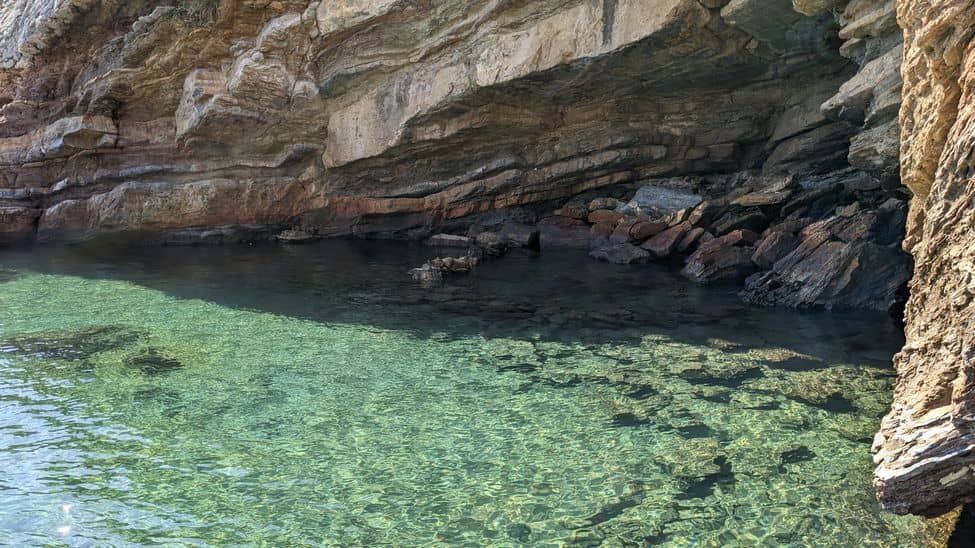
2- Explore the island’s two main port cities
Agios Kirykos is the island’s administrative capital and Ikaria’s main port. Lively in all seasons, stroll along the harbor to see the huge statue of Icarus, or Gorgona, the mermaid of Icaria. But it’s much nicer to relax on a cafe terrace, like the Greek papuans playing backgammon in the square near the little church of Agios Nikolaos, or to do a little shopping in the little street called “Pasaje”.
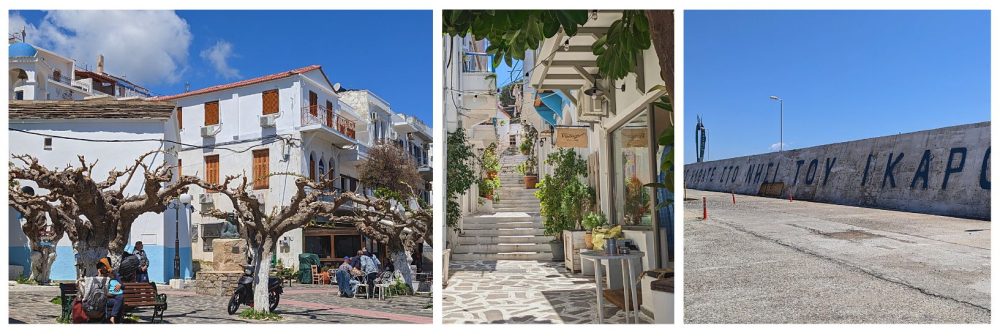
Evdilos, the island’s second port, is a pleasant little town. It has retained all the charm of a fishing port, with a lively square, taverns and cafés lining the harbor, making it a pleasant place to stop. Don’t hesitate to climb up and wend your way through the little streets to get a feel for the atmosphere of Evdilos.
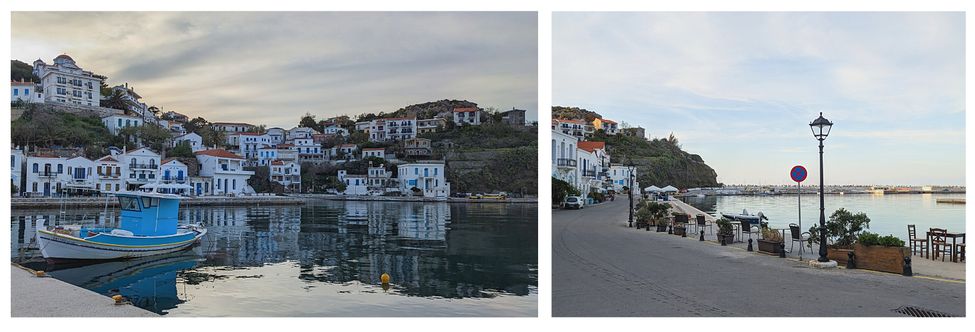
3 – Stop off in small fishing villages
During our stay, we discovered charming, typical fishing villages. Places where you can spend the day in peace and quiet, alternating between a swim and a table by the water, contemplating the sea. Little corners of paradise where time stands still…
Karavostamo
Karavostamo is a small fishing village on the island’s north coast. Park your car at the entrance near the square and stroll through the narrow streets. A number of cafes and tavernas face the sea, but few are open in low season. The village also has a small pebble beach ideal for children to play on.
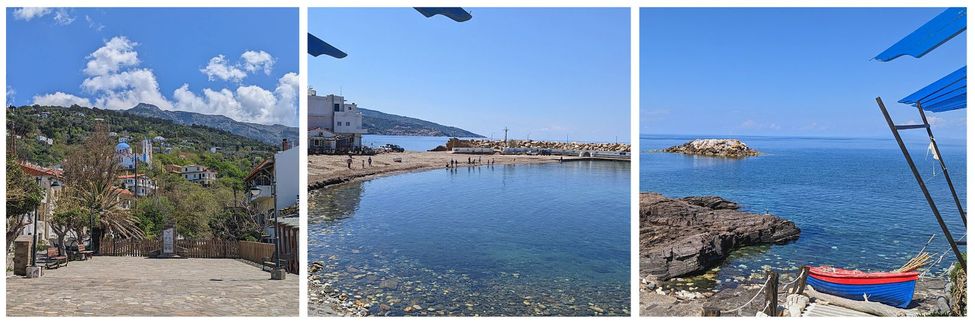
Gialiskari
Gialiskari, between Evdilos and Armenistis, is a picturesque little marina with everything you could wish for. Below the busy road, a street lined with a few tavernas and a cafe with terraces overlooking the sea. We particularly enjoyed the view from the terrace of the O Kialaris tavern and the atmosphere it created. Or head to the end of the peninsula to the pretty Analypsi church, with its white facades and blue dome. You will then walk along a small beach with translucent blue water before arriving at the small port. On the other side is the large and beautiful Mesakti beach.

Magganitis
Magganitis is a small port in the very south of the island, just past the Seychelles beach. An authentic village with few tourist facilities. In low season, kafeneio and tavernas were closed at the time of our visit. Situated at a lower level and with winding little streets, we recommend parking in the small square above the Kafeneio and Agios Nikolaos church. Nearby, the small Firodi beach (towards the Seychelles) is recommended by locals.
4 – Discover the most beautiful beaches on the island of Ikaria
Ikaria has many different beaches, each with its own special charm! Here are a few of our favorites.
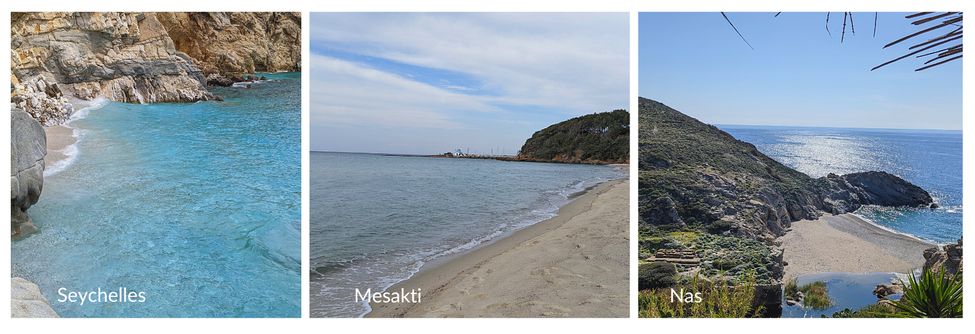
Seychelles beach
Located on the south coast of the island towards Magganitis, this beach owes its name to its resemblance to the famous paradise beaches. Turquoise-blue water from the white pebbles on the shore. But be warned, this magnificent beach has to be earned. After parking in the free parking at the roadside, it’s a 10-15 minute walk downhill on a stony path. Good to know: bring closed shoes, drinks, parasol… What’s more, access to this beach is not suitable for small children. During our stay in April, there was too much wind and current to go onto the beach without getting completely wet. But in summer weather, it’s perfectly accessible. In season, there are also boats from Magganitis that take you to the beach by sea.
The beaches of Armenistis
Mesakti beach : Close to the seaside village of Armenistis, this is a large, beautiful sandy beach. Situated on the north coast of the island, it’s more prone to winds, making it a popular spot for windsurfers in particular. There’s also a surf school, Ikaria Surf School, which offers surf rentals and surf lessons, as well as SUP rentals and SUP lessons (in English). There are also beach bars that set up part of the beach with deckchairs in summer. Stroll towards the Analipsi church, recognizable by its blue dome, and you’ll come to the place where the water from the mountains flows into the sea, forming a kind of marsh (with its frogs). An unusual corner…
Armenistis beach: Nearby, you’ll find Armenistis beach, another beautiful sandy beach.
Nas beach
It’s a small, pleasant beach of pebbles and sand, framed by rocks. Beware, it seems to gain depth rather quickly. Easily accessible via a paved path, it also houses the remains of the temple of Artemis Tavropolos.
And many more beautiful beaches
Agios Georgios beach: A beach reached after a short stroll from the Drakano tower at the far end of the island towards Agia Kyriaki. Clear blue water, far from the crowds!
Nealia beach: On the south coast, a pretty, undeveloped sandy beach. We had selected it but couldn’t go and see it. Access is via a dirt track that’s not very passable, and we were beginning to get a bit burnt out with our rental car, which didn’t have much headroom….
Kerame beach: Not exactly a must-see, but we really enjoyed this small pebble beach with its clean waters and easy access by car.
5 – Take a stroll and hike along the paths of Ikaria
Ikaria is a green, mountainous island, ideal for walking and hiking. Here are 2 easy walks we’ve tried:
Drakano Tower, church and Agios Georgios beach – approx. 1-hour walk (round trip)

First of all, you have to get to the Drakano Tower at the end of the island towards the airport, past Fanari. The road is quite difficult, an uneven dirt track with numerous potholes and large stones. As our rental car is unsuitable, we prefer to park 700m before the tower and begin the walk by continuing along this path. After 10 mins, we reach the archaeological site and the round tower of Drakano. If you arrive during opening hours (8.30 a.m.-3 p.m., Tuesday to Saturday), you may be lucky enough to visit this Cyclopean defensive tower. Access is free of charge.
From the tower, take the small path along the fence into the garrigue, then turn left to reach the charming little church of Agios Georgios. Don’t turn back just yet, and continue on to Agios Georgios beach, a pretty beach of pebbles and sand with translucent water. You’ll also enjoy a beautiful view of Samos. For the return journey, you can follow the path all the way without turning off at the tower, and get back to your car more quickly.
To Fellodentro cork tree and Agia Sofia church – approx. 40 mins walk (round trip)
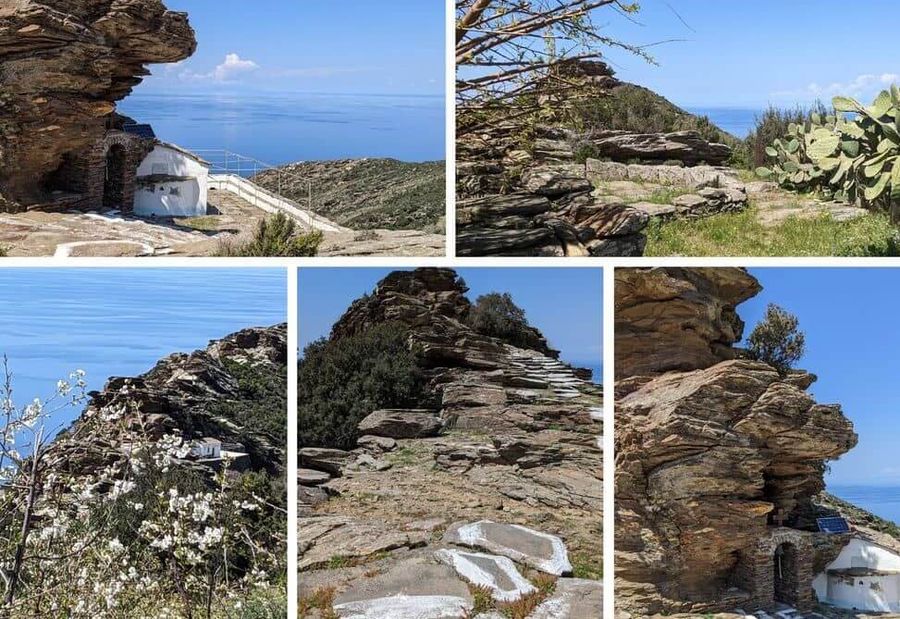
Near the village of Monokampi, take a look at the century-old “To Fellodentro” cork tree by the roadside. Then head for the shaded esplanade below, with its many terraces and village festivals. From the site, follow the wall on the left, head towards the sanitary building and down the path that runs alongside a few houses. Continue up the few steps to the right, then at the large tree, turn right onto the road. Go past the houses and continue along the path to the left. Then just follow the path marked with large white signs, pass through the 2 gates and you’re at the Agia Sofia church. Admire the beautiful view of the valley and sea from the small square.
And plenty of other ideas for walks to discover the flora and fauna.
There are also many hiking trails, starting from Rahes or Kambos for example. Some are difficult to access. You can find different routes on the AllTrails or Wikiloc websites. But also on the Anavasi card, on sale for €8.5 at Ikaria airport in particular. It lists all the hiking trails in Ikaria (in Greek and English).
- The ancient forest of Ranti
- Byzantine castle of Koskina
- Lake Selini and the Ryakas waterfalls
For even more ideas, take a look at the Facebook page of OPS Ikarias, the Ikariote hiking club that marks and maintains the island’s hiking trails.
During your walks around the island, you’ll be able to appreciate Ikaria’s varied flora and fauna. You’re sure to come face to face with these large lizards (Laudakia Stellio) also known by this evocative name: κροκοδειλάκι (little crocodiles). Some areas of Ikaria are also part of the Natura 2000 network , to preserve the island’s environment and biodiversity.
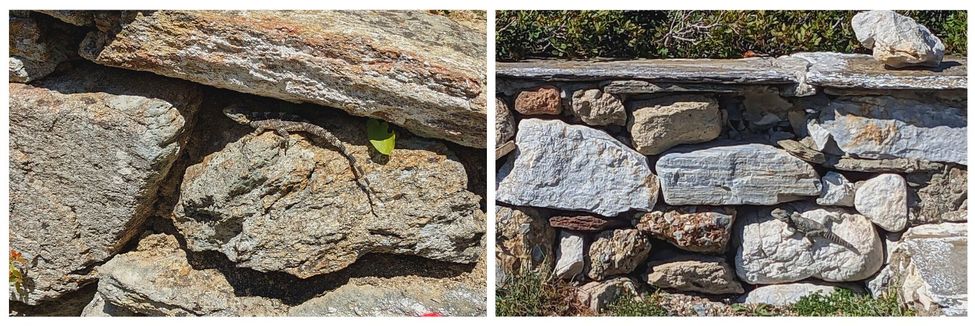
6 – Discover the amazing monastery of Ikaria
If there’s one monastery to visit in Ikaria, it’s the Monastery of Osias Theoktistis. This small monastery is located in the village of Pigi, above Kambos, and dates back to before 1688. It features a church with beautiful murals. And a little further on, an astonishing chapel built on a promontory with a huge flat rock as a roof. Today, no monks live there. During the tourist season, there’s a café serving loukoumades and a few local products for sale.
Here’s a tip: For a superb view, walk around the chapel to the right, stand on its roof and admire…
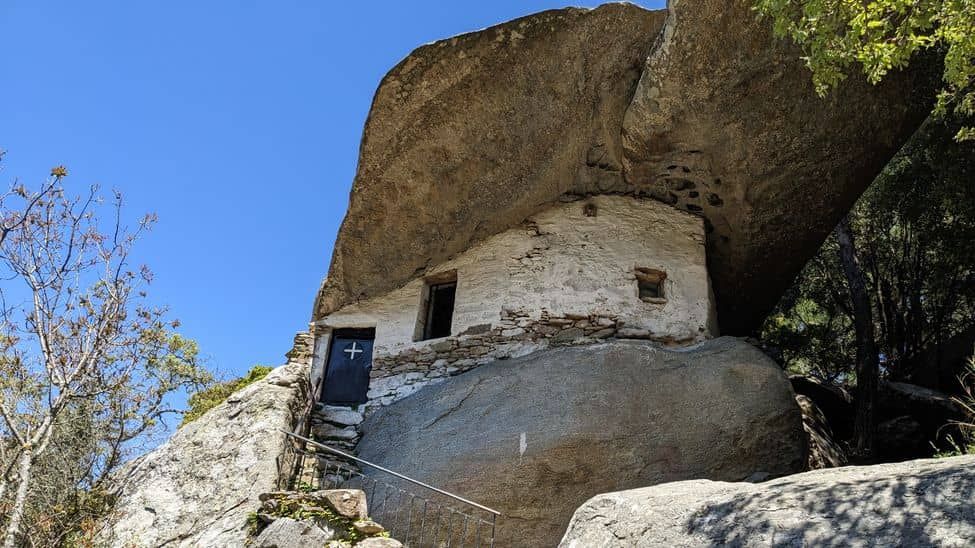
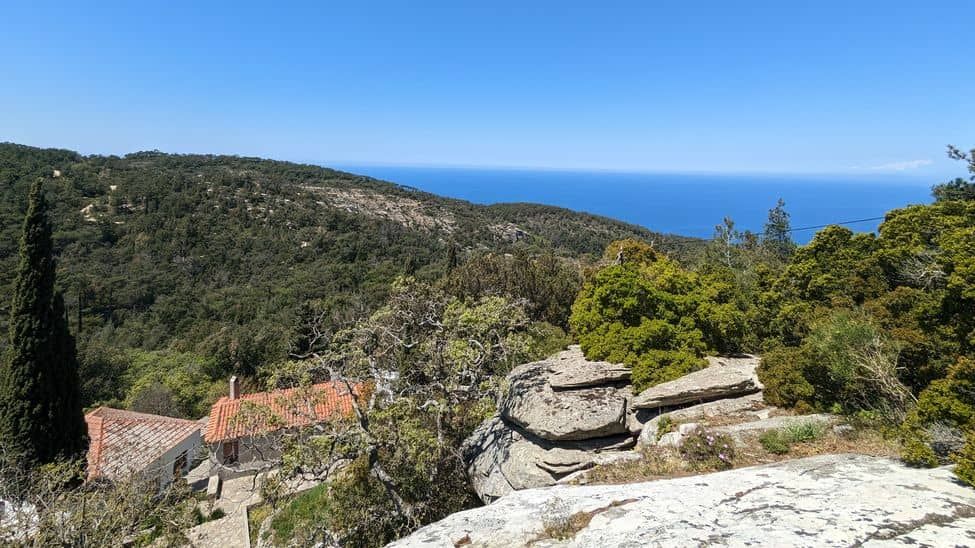
After visiting the monastery, don’t miss a stop at the Karimalis wine farm. Here you can enjoy a fine local wine served with entirely homemade dishes. With the added bonus of a beautiful view over the valley. The kind of agri-tourism we love!
7 – Visiting archaeological sites
So we’re warning you right now, if you’re an archaeology buff, you’re in for a disappointment. On Ikaria, there are no major must-see sites with the wow effect, but rather small, pleasant visits to be combined with another point of interest, such as a beach.
The Artemis Tavropoulo Temple on the beach at Nas
Situated in a sunken cove, access to the temple of Artemis is free and via a small street to the right of the parking lot, which leads to Nas beach. The path is paved and well-marked, accessible in flip-flops. To get down to the beach, however, you’ll have to get your feet wet at the very bottom of the rocks and reeds.
Then follow the marsh to the rhythm of the frogs’ songs, skirt the stone wall and you’ll arrive at the Temple of Artemis. More precisely, the ruins of this temple dating from the 5th century BC. All that remains is the base and a few scattered pieces of marble.
However, the setting is bucolic and offers a beautiful view of the beach that awaits you to complete the visit. It’s well worth a visit, especially at sunset!

The Oianades archaeological site at Kambos
Park at the cafe and take the street that runs up to the right of the small square. The archaeological site is quite small and consists of :
- Agia Irini church, the oldest in Ikaria. Rebuilt in the 12th century from the remains of the early Christian basilica (4th century), of which only the pillars remain.
- a small archaeological museum open from 8:30 a.m. to 3:30 p.m. (closed in low season)
- The Odeon, which can be seen a little further along the rue
Kambos is the starting point for many beautiful hikes, or you can enjoy the surrounding sandy beaches.
8 – Spend the evening in mountain villages like Rahes
In Ikaria, Rahes or Christos is a favorite spot for night owls. Indeed, in this authentic village, while everything is closed during the day, as soon as night falls, Rahes wakes up. Shops open and cafes and tavernas fill up for most of the night.
This particular way of life dates back to the time when the villagers took refuge in the mountains, out of sight of the pirates. A time when they have become accustomed to living after dark. By day, the island seemed uninhabited.
You’ll also notice (or not) some very special stone houses, the anti-pirate houses. Built against a rock, with stone walls and a roof made of flat rock, they are hidden by vegetation and blend into the background. Architecture unique to Ikaria!
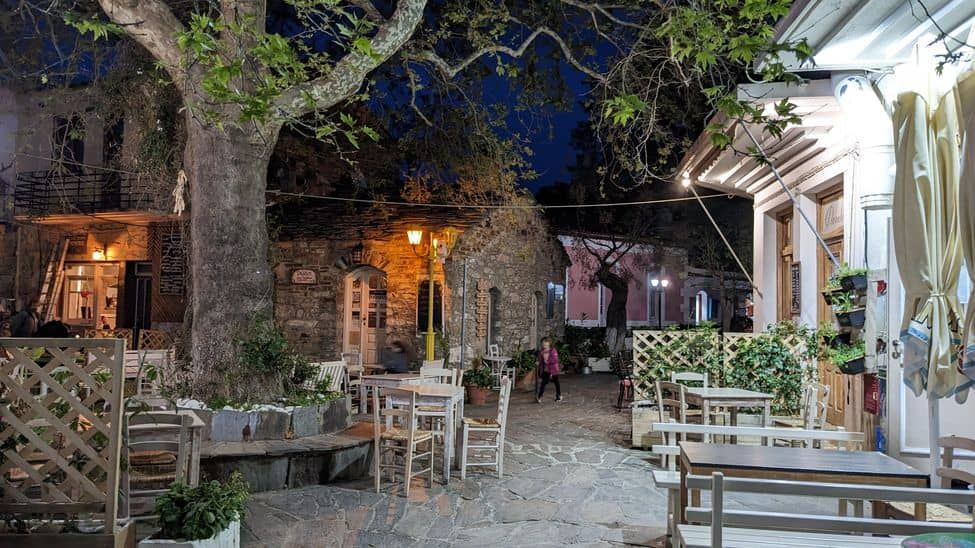
9 – Attend one of the many panigyria
Ikaria is known as the island of centenarians. They owe this to their simple diet based on local produce and to their lifestyle (even the elderly continue to work). But it’s also thanks to their philosophy of life. Icariotes love to dance and even have their own island-specific dance called Ikariotikos.
So there’s no better way to learn than by attending a panigyri, the traditional village festival in honor of a patron saint. In Ikaria, the panygiria are famous and attract large crowds. They take place mainly in the summer. So if you’re in Ikaria in August, don’t miss the festivities of Raches.
The Visit Ikaria website lists some of the local feasts traditionally held on the island: Panygiria in Ikaria.
10 – Tasting Icariote specialities
On Ikaria, the way we eat certainly plays a part in the island’s reputation for longevity. Healthy food, quality local produce from the island, little meat, all washed down with a good full-bodied red wine! Discover all the culinary specialties of Ikaria:
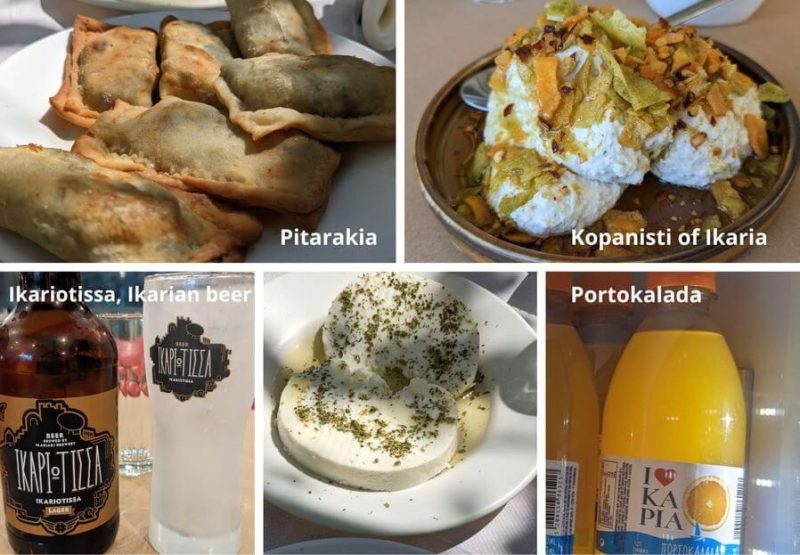
Local ingredients
- Kathoura, a local goat’s cheese. You’ll also find Kopanisiti from Ikaria, which is very strong in taste!
- Soufiko, an authentic vegetarian dish cooked with garden vegetables: zucchinis, tomatoes, eggplants, carrots, potatoes…and olive oil, of course!
- Pitarakia, a pita made with Ikaria herbs such as chorta or fennel.
- The kolokasi is a rare Greek vegetable found only in Ikaria. It’s a type of sweet potato, but beware, it’s toxic if eaten raw!
- Honey from Icaria or anamatomelo is a fairly thick honey. Made from heather bush, it is renowned for its health-giving properties.
- Glyko tou Koutaliou, these candied fruits are a Greek specialty. On Ikaria, it’s made from local produce such as apricots (kaïssia), oranges, bergamot, cherries and roses.
- Naturally-grown herbs also play an important role in Ikari cooking: mint, oregano, thyme, chamomile, sage, rosemary, fennel…
- The wild goat or raska that grazes in the mountains is low in fat and full of flavor. It is eaten boiled as a stew or grilled.
- Local olive oil is of excellent quality and produced in sufficient quantities to meet the needs of Ikariotes.
And don’t forget to keep well hydrated…
- Pramnos wine, a dry, full-bodied red (over 16 degrees). A wine linked to mythology, since Dionysus is said to have been born on the island of Ikaria, next to a mountain, Pramni, where the vines that produce Pramnos wine were grown. On Ikaria, there are 4 wineries producing dry, semi-dry and sweet white, rosé and red wines.
- But also other drinks like orange and lemon sodas or the local Ikariotissa beer, all prepared with Ikaria spring water renowned for its health-giving properties!
So here are our top 10 must-see and must-do activities in Ikaria in just a few days. There are many more places to visit… But especially in Greece, and even more so on Ikaria, take the time to sit back and enjoy the moment!
Now, you can prepare your trip to Ikaria with our Travel Guide.
Virginie W.
Updated February 9, 2024
